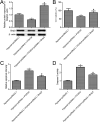Retracted Article: FOXO4 overexpression suppresses hypoxia-induced-MCF-7 cell survival and promotes apoptosis through the HIF-2α/Bnip3 signal pathway
- PMID: 35530114
- PMCID: PMC9070021
- DOI: 10.1039/c9ra04380b
Retracted Article: FOXO4 overexpression suppresses hypoxia-induced-MCF-7 cell survival and promotes apoptosis through the HIF-2α/Bnip3 signal pathway
Retraction in
-
Retraction: FOXO4 overexpression suppresses hypoxia-induced-MCF-7 cell survival and promotes apoptosis through the HIF-2α/Bnip3 signal pathway.RSC Adv. 2021 Jan 22;11(8):4573. doi: 10.1039/d1ra90014e. eCollection 2021 Jan 21. RSC Adv. 2021. PMID: 35747605 Free PMC article.
Abstract
Transcriptional regulator forkhead box O (FOXO) has implications in many diverse carcinomas and often acts as a tumour suppressor. Evidence suggests that FOXO4 may play a role in cancer cell proliferation and apoptosis; however, the function and mechanism of FOXO4 on breast cancer cell growth are still unknown. FOXO4 can respond to hypoxia and in the current study, our aim is to investigate the function and molecular mechanism of FOXO4 in hypoxia-induced MCF-7 cells. We first observed that hypoxia treatment reduced FOXO4 mRNA and protein expression in MCF-7 cells. Moreover, FOXO4 overexpression reversed hypoxia-induced MCF-7 cell survival. Hypoxia treatment markedly impeded MCF-7 cell apoptosis and inhibited caspase-3 activity, whereas FOXO4 overexpression promoted apoptosis and increased caspase-3 activity in hypoxia-induced MCF-7 cells. Further studies indicated that FOXO4 overexpression inhibited hypoxia-induced HIF-2α and Bnip3 expression in MCF-7 cells; moreover, FOXO4 suppressed Bnip3 expression, which is dependent on the low level of HIF-2α. Finally, we demonstrated that Bnip3 overexpression reversed the effects of FOXO4 overexpression on cell survival and apoptosis in hypoxia-induced MCF-7 cells. In conclusion, the present study suggests that FOXO4 overexpression mediated the HIF-2α/Bnip3 signal pathway, which has implications in cell survival and apoptosis in hypoxia-induced MCF-7 cells.
This journal is © The Royal Society of Chemistry.
Conflict of interest statement
The authors declare no conflict of interest.
Figures





References
-
- Sorlie T. Perou C. M. Tibshirani R. Aas T. Geisler S. Johnsen H. Hastie T. Eisen M. B. van de Rijn M. Jeffrey S. S. Thorsen T. Quist H. Matese J. C. Brown P. O. Botstein D. Lonning P. E. Borresen-Dale A. L. Proc. Natl. Acad. Sci. U. S. A. 2001;98:10869–10874. doi: 10.1073/pnas.191367098. - DOI - PMC - PubMed
Publication types
LinkOut - more resources
Full Text Sources
Research Materials

